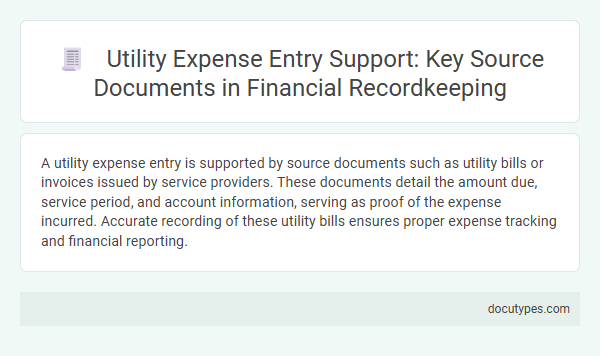A utility expense entry is supported by source documents such as utility bills or invoices issued by service providers. These documents detail the amount due, service period, and account information, serving as proof of the expense incurred. Accurate recording of these utility bills ensures proper expense tracking and financial reporting.
Introduction to Utility Expense Entry in Finance
Utility expense entry in finance records the costs incurred for services like electricity, water, and gas used by a business. Accurate source documents ensure your financial records reflect actual expenses, aiding in budgeting and reporting. Common supporting documents include utility bills and invoices provided by service companies.
Importance of Accurate Utility Expense Documentation
Utility expense entries require precise source documents to ensure accurate financial records and effective budgeting. Proper documentation supports audit trails and verifies the legitimacy of expenses for utility costs like electricity and water.
- Utility Bills - These are primary source documents providing detailed charges, dates, and service usage essential for recording expenses.
- Payment Receipts - Receipts confirm that payments for utility services have been made and match the amounts recorded in your accounting system.
- Service Contracts - Contracts outline agreed rates and terms, helping validate and explain variances in utility expenses over time.
Types of Utility Expense Source Documents
Utility expense entries are primarily supported by source documents such as utility bills, invoices, and payment receipts. Utility bills provide detailed information on the amount of consumption and charges for services like electricity, water, and gas. Payment receipts confirm the settlement of these bills, ensuring accurate recording and reconciliation of utility expenses in financial records.
Utility Bills: The Primary Reference
Utility bills serve as the primary source document supporting utility expense entries in financial records. These bills provide detailed information, including the service period, consumption data, and total charges, essential for accurate accounting.
Accountants rely on utility bills to verify and record utility expenses, ensuring compliance with financial reporting standards. Proper documentation helps maintain transparency and facilitates audits by substantiating the recorded expenses.
Receipts and Payment Confirmations for Utilities
Utility expense entries are substantiated by source documents such as receipts and payment confirmations that verify the transaction. These documents provide essential proof of payment and expense details for accurate financial records.
Receipts from utility providers capture the amount paid, service period, and payment date. Payment confirmations serve as formal acknowledgment from your bank or utility company showing successful transaction completion.
- Receipts - Confirm the exact utility charges and payment date issued by the utility company.
- Payment Confirmations - Provide evidence of funds transfer from your bank to the utility provider.
- Supporting Documentation - Ensures proper audit trail and compliance with accounting standards.
Supplier Contracts and Service Agreements
Utility expense entries are typically supported by supplier contracts and service agreements. These documents outline the terms, rates, and conditions agreed upon between your company and the utility provider.
Supplier contracts verify the cost structure and service details, ensuring accuracy in financial records. Service agreements confirm the ongoing provision of utility services, serving as essential evidence for expense recognition.
Electronic Utility Statements and E-Billing
Electronic utility statements and e-billing serve as primary source documents supporting utility expense entries in financial records. These digital documents provide detailed transaction information necessary for accurate accounting.
Electronic utility statements contain itemized charges, usage data, and billing periods that validate the recorded expenses. E-billing platforms offer secure access to invoices and payment confirmations, ensuring reliability and audit readiness. Utilizing these electronic sources enhances accuracy and streamlines the expense verification process.
Common Errors in Utility Expense Entry
What type of source document supports a utility expense entry? A utility bill from the service provider serves as the primary source document for recording a utility expense. Accurate entry depends on verifying the bill's details, including the billing period, amount due, and account number.
What are common errors in utility expense entry? Common errors include data entry mistakes such as incorrect amounts or dates, duplicating entries, and failing to match the expense with the correct billing period. These errors can lead to inaccurate financial records and affect your budgeting and reporting accuracy.
Best Practices for Utility Expense Recordkeeping
| Source Document Type | Description | Best Practices for Recordkeeping |
|---|---|---|
| Utility Bill | Official invoice from utility providers such as electricity, water, gas, or sewage services detailing charges for consumption over a billing period. | Retain original or digital copies with clear billing dates, account numbers, and amounts. Match bills with payment records to ensure accuracy. |
| Payment Receipt | Proof of payment issued by the utility company confirming the amount paid for the utility service. | Store payment receipts alongside utility bills. Ensure receipts include payment method, date, and amount to validate expense entries. |
| Bank Statement | Financial institution report showing withdrawal or payment made to utility providers. | Cross-verify transactions with utility bills and payment receipts. Use statements to reconcile discrepancies in expense records. |
| Meter Reading Report | Document showing recorded utility consumption used to calculate bill charges. | Maintain meter readings to support charges in utility bills. Use for audit trails and verifying accuracy of expenses. |
| Expense Journal Entry | Accounting record documenting the utility expense entry in the general ledger. | Reference corresponding source documents such as utility bills and payment receipts for each journal entry to uphold internal controls. |
What Type of Source Document Supports a Utility Expense Entry? Infographic

